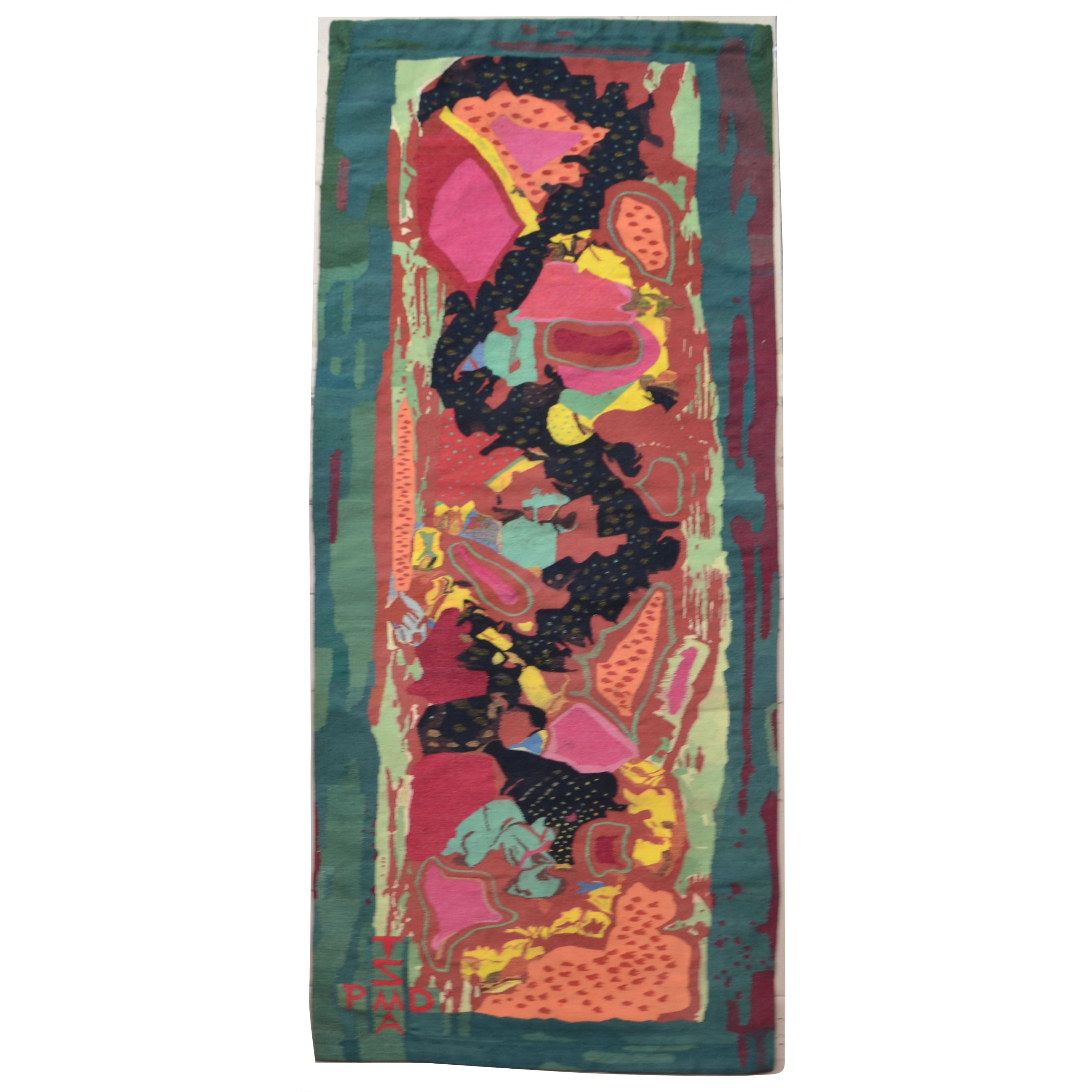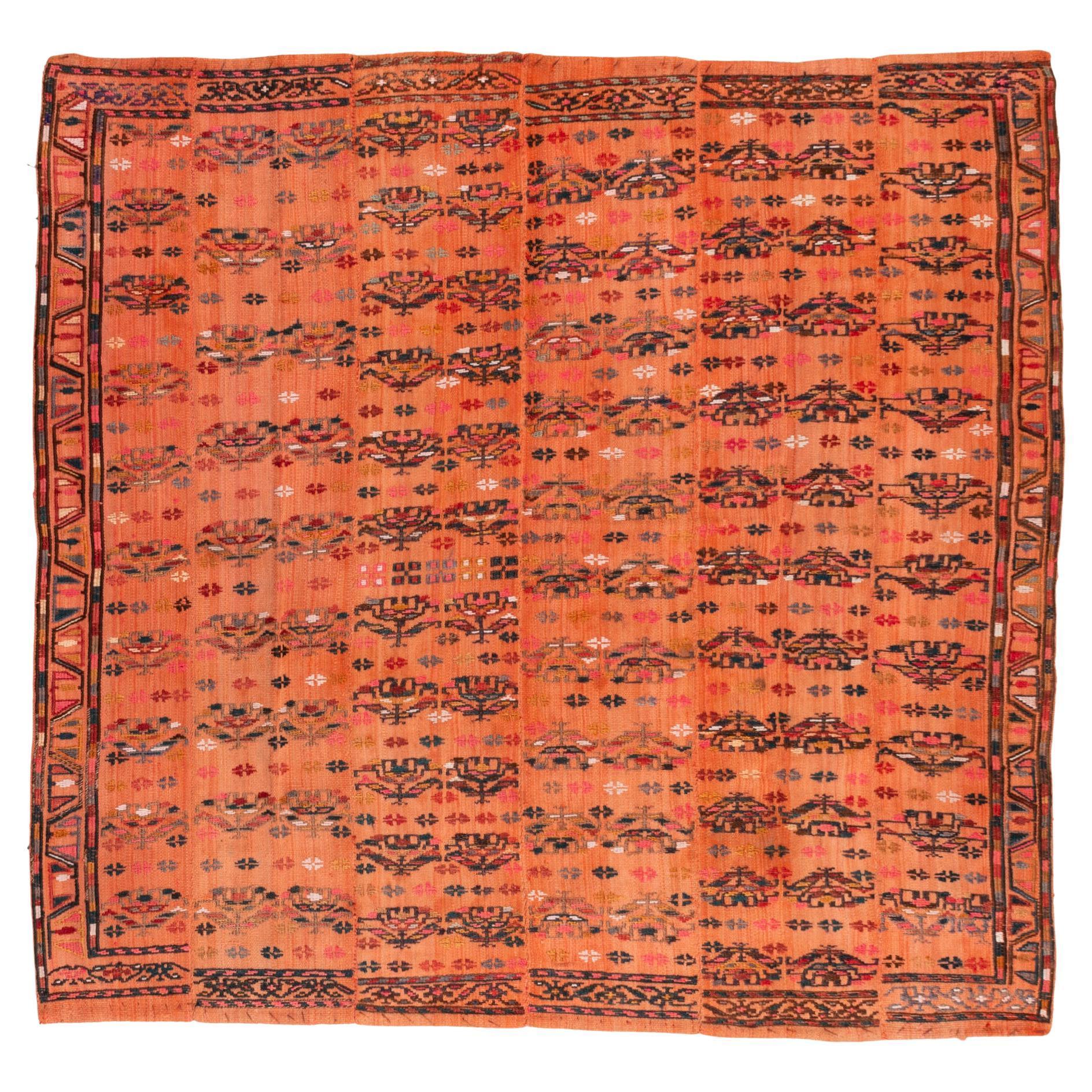Items Similar to Beatles Fabric Holland, circa 1964
Want more images or videos?
Request additional images or videos from the seller
1 of 12
Beatles Fabric Holland, circa 1964
About the Item
Curtain fabric made by N. V. Stoomweverij Nijverheid Enschede, Holland [NV Steam Weaving] in green with the Fab Four in various poses, singularly and as a group with song titles, as a repeat pattern. Very usable length at 1.8 meters and in excellent condition without any fading or sun damage. Has been pinned at the 2 top corners but in the selvage. Dates from circa 1964.
- Creator:N.V. Stoomweverij Nijverheid (Manufacturer)
- Dimensions:Height: 70.87 in (180 cm)Width: 47.25 in (120 cm)Depth: 0.08 in (2 mm)
- Style:Mid-Century Modern (Of the Period)
- Materials and Techniques:Fabric,Dyed
- Place of Origin:
- Period:
- Date of Manufacture:circa 1964
- Condition:Wear consistent with age and use.
- Seller Location:Pymble, AU
- Reference Number:
About the Seller
5.0
Vetted Seller
These experienced sellers undergo a comprehensive evaluation by our team of in-house experts.
Established in 2004
1stDibs seller since 2015
162 sales on 1stDibs
Typical response time: 18 hours
- ShippingRetrieving quote...Ships From: Pymble, Australia
- Return PolicyThis item cannot be returned.
More From This SellerView All
- Bitossi, Londi Designed Lion Series 'Pietra', circa 1964, ItalyBy Aldo Londi, BitossiLocated in Pymble, NSWAldo Londi designed bronze finish lion called 'Pietra', early 1960s. This was also made as a lamp base and finished with different glazes. The 'bronze' finish as here is very rare. S...Category
Vintage 1960s Italian Mid-Century Modern Pottery
MaterialsPottery
- Zaccagnini Pharaoh's Head Italy, circa 1955By Urbano Zaccagnini, Ugo ZaccagniniLocated in Pymble, NSWA brilliant Pharaoh's head with bright metallic glazes of silver and gold mounted on a black finished wooden base. Marked with a 'Z' on the base. Of large size this is an imposing de...Category
Vintage 1950s Italian Mid-Century Modern Pottery
MaterialsPottery
- Roberto Rigon Italy Bull, circa 1970By Roberto RigonLocated in Pymble, NSWAn exceptional Roberto Rigon bull in 'Smalto Sasso' [glazed stone] with yellow, red and green lines. Base is marked RR. Pieces with painted or tube-lined geometric patterns are rare.Category
Vintage 1970s Italian Mid-Century Modern Ceramics
MaterialsPottery
- Marcello Fantoni lampbase, Italy, circa 1958.By Marcello FantoniLocated in Pymble, NSWA large Fantoni lampbase in yellow with a single female figure and decorative cartouches and a column to the rear. Italy, circa 1958, marked to the base.Category
Vintage 1950s Italian Mid-Century Modern Table Lamps
MaterialsPottery
- Pesaro, Renato Giavoli Italy, circa 1960 CrocodileBy PesaroLocated in Pymble, NSWAn impressive crocodile by Renato Giavoli made in the early 1950s at his factory in Pesaro Italy. He was a maestro of Italian ceramics and this is being...Category
Vintage 1950s Italian Mid-Century Modern Ceramics
MaterialsPottery
- Fratelli Fanciullacci Italy Tribal Vase, circa 1968By Fratelli FanciullacciLocated in Pymble, NSWA large Fratelli vase decorated with creamy glaze 'Tribal' figures on a blue glaze background. Beautifully detailed with all the figures being different. The glaze is semi matte and ...Category
Vintage 1960s Italian Mid-Century Modern Pottery
MaterialsPottery
You May Also Like
- "Deer Season", Rare Art Deco Fabric Designed by Rockwell Kent, circa 1950By Rockwell KentLocated in Philadelphia, PAThis rare and striking Art Deco fabric panel, featuring a running deer in a forest expressed in rich red and maize, was designed by Rockwell Kent for Bloomcraft Inc. in 1950. The de...Category
Vintage 1950s American Art Deco Tapestries
MaterialsFabric
- French Artist Charles Lapicque Tapestry Limited Edition 1/2 "Pelops", 1964By Charles LapicqueLocated in Paris, FranceExceptional limited edition 1/2 tapestry "Pelops" with certificate from a private collection, 1964. Ateliers Pinton brothers in Felletin, under the supervision of Pierre Baudouin 2ex + 1EA Editor Aram Iynedjian. The tapestry will be sold with its certificate of authenticity from the gallery. From the 15th century, the name of Pinton was associated with the Aubusson tapestry. Since then, over the generations, the Pinton family has largely contributed to the development of this fabulous cultural heritage until the creation in the 19th century, of the Felletin factory, in the department of Creuse. Even today, in these workshops, the craftsmen execute the same correct gestures with the same attention to detail and thus extend the chain of the history of the tapestry of tradition but also contemporary. The hand of specialists, the eye of designers and dyers and the taste of the most demanding clientele find their meaning in the fabric of the carpets. The excellence of French know-how, a living heritage society and custodian of Aubusson's cultural heritage, has always collaborated with great artists. The works of Charles Le Brun, Charles Lapicque, Pablo Picasso, Jean-Michel Othoniel, and many other big names in the world of painting, architecture, design, fell into the looms and know-how ancestral of this unique Creuse creator. Editor Aram Iynedjian Aram Iynedjian, Lausanne gallery owner and editor of tapestries from Braque, Estève and Lapicque, the latter meets Pierre Baudouin, the most famous of the cardboard painters of the time. The one who translated the works of Le Corbusier, Calder or Picasso into tapestry then collaborates with Charles Lapicque and they will develop a work of great richness. Lapicque came to realize these two summits which are "Pélops" and "Diane et Actéon". I realize that you should never try to describe a work of art Let’s look at it. Let us admire the science of composition, linear purity, technical perfection, the beauty of color, the truth of the drama. Let us see, if we can, the implacable presence of genius. "We will now understand that after having based a painting on the love of tapestry, it was relatively easy, and very tempting, to build a tapestry faithful to my painting," explained the artist in the exhibition catalog. of the Galerie Verrière in 1970. It was not until 1961 that he began to produce cardboards both for the tapestry of the Lisse in Aubusson, but also at the Mobilier National, with the help of Pierre Baudouin Charles Lapicque (1898-1988) Born in 1898 in Theizé (Rhône) in a family practicing both the arts and the sciences, Charles Lapicque is no exception to the rule: gifted for music and drawing, he graduated from the École Centrale in 1921, works as engineer until 1928 before integrating in 1931 a laboratory at the Faculty of Sciences of Paris, where he carried out research on the perception of colors, crowned by the title of Doctor of Physical Sciences in 1938. He thus studies the reactions of the eye in front of an intense light source, at the origin of the formation of starry images which he will use in his works, and defines a theory of the staggering of colors in space which overturns the rules of the Renaissance: "I had shown that the Classic rule, that of Vinci, advocating placing the blues in the distance, the reds, oranges and yellows in the foreground, is a nonsense; it makes more sense, more favorable to do the opposite. "(In Red and blue in the arts, 1936) It was around 1920 that Charles Lapicque began to paint in Brittany where he spent every summer since his childhood, first on the motif and then in a workshop that his stepfather Jean Perrin, Nobel Prize in Physics, had him build in 1927 ; he then definitively adopted the work of memory, in accordance with the art of music which he deeply loved and the Bergsonian philosophy of knowledge: "It is up to us to give reality an appearance that it has no itself, a form, a figure (...). " His youthful production immediately reveals a great originality, oscillating between figuration and abstraction which sometimes intertwine: alongside synthetic paintings by their simplified drawing and their flat colors, he designs an Homage to Palestrina (1925), composed of a grid derived from Cubism, entirely abstract, relayed by a Christ with Thorns (1939), according to a principle that he will develop after 1939, in line with his optical discoveries. In fact, during the war years, an almost abstract period began, that of the tight blue framework, applied to backgrounds ranging from yellow to red and revealing a more or less identifiable world (Jeanne d'Arc crossing the Loire, 1940; Rencontres series, 1940-1945). Exhibited in 1929 by the gallery owner Jeanne Bucher, Lapicque abandoned his scientific career in 1943 to devote himself entirely to painting. He continued his work which resulted in 1946-1953 in white-frame structures; their much softer lines lead him to the system of either black or white interlacing which encloses areas of pure color, most often in solid color. With The Battle of Waterloo in 1949, Lapicque still uses optics - zooming in on a given area - to depict spaces with multiple perspectives and decomposed times. This new interest in the liveliness of color developed in the following period, which can be described as flamboyant or Baroque (1954-1963): illustrated in particular by the series of Breton lagoons and twilight or nocturnal views of Venice in the light. Stars, which the artist himself describes as “daring sweets”, it begins with the Raoul Dufy Prize of the Venice Biennale, awarded in 1953 to the artist who took the opportunity to give free rein to his passion for the Serenissima until July 1956. Another point in common with his elder brother is the expression of movement. Begun in 1949 in The Battle of Waterloo then in 1952 with Dimanche aux regates, it became an obsession from 1964, in the exploration of new themes, such as the different shots of tennis players captured on the fly (1965), the mythological scenes and sea storms. These dizzying years precede the artist's last period: as he comes of age, he discovers serenity, revealed by a painting now with acrylic paint, much more peaceful from 1974, which even borders on a childish naivety at the end. of his life. All of his work includes an astonishing diversity of themes, also nourished by his travels (Rome in 1957, Greece in 1964, Holland in 1974 ...), with a predilection for the sea, rocks, sailboats, music, tennis, horses, wild beasts, but also for history and mythology, as evidenced by knights, kings and ancient gods. It also deploys, in total creative freedom, a wide variety of styles and orientations. Having been one of the pioneers of non-figurative art, thus paving the way for artists like Manessier, Bazaine, Vieira da Silva, De Staël, etc. Owners of the new non-figurative Paris School of the Postwar period, Charles Lapicque then returned to figuration, in a "new interpretation" of appearance, even if he continued to rub shoulders with abstraction at times. "Drawing runs after color and color after drawing. " Heir to the Fauves, Charles Lapicque plays like them on pure colors, whose dissonances, associated with a totally free design and an overloaded composition in a multiple space, make him a precursor of the New Figuration in all its forms: the Narrative Figuration born in France in the early 1960s, represented in particular by Gérard Fromanger, Erró, Bernard Rancillac and Gérard Guyomard; Free Figuration born in the early 1980s, marked by Robert Combas, Hervé and Richard Di Rosa, Louis Jammes and François Boisrond, and which, in turn, influenced the American Bad Painting of a Jean-Michel Basquiat or a Keith Haring, deliberately neglected and Expressionist; Lapicque's “Classic subjects” were able to feed Cultivated Painting, which also appeared in the early 1980s with Jean-Michel Alberola, Patrice Giorda and Gérard Garouste...Category
Mid-20th Century European Tapestries
MaterialsWool
- Expressive Multi Color Hand Woven Tapestry, Dutch, 1961Located in London, GBHandwoven wall tapestry named 'Dragon and Anti-Dragon' by Rudolf Boorsma at atelier Paula Dietz 1961 in the Netherlands. It is a dynamic and colorful wall hanging. The composition is...Category
Vintage 1960s European Mid-Century Modern Tapestries
MaterialsWool
- 1950s Barney Reid Screen Printed Fabric PanelBy Barney ReidLocated in San Diego, CAScreened printed fabric panel with stylized abstract figures by Barney Reid. Retains original tag as pictured. Acquired directly from the artist ...Category
Mid-20th Century American Mid-Century Modern Tapestries
MaterialsFabric
- Oriental Old "Cicim" Embroidered FabricLocated in Alessandria, PiemonteApricot background, all embroidered loom fabric, panel by panel, embroidered entirely by hand. It was woven by nomadic girls for their wedding trousseau. Not being able to have a fix...Category
Mid-20th Century Turkish Other Turkish Rugs
MaterialsWool
- Embroidered Turkish Karapinar Carpet or FabricLocated in Alessandria, PiemonteNr. 788 - Hand embroidered carpet or fabric by young Turkish nomad girls for their wedding trousseau. Flat wave kilim: this is not a true rug, but a fabric made by young Turkish noma...Category
Mid-20th Century Turkish Other Turkish Rugs
MaterialsWool
Recently Viewed
View AllMore Ways To Browse
Vintage Tapestry Fabric
Retro Tapestry Fabric
Modern Tapestry Weaving
Tapestry Netherlands
Midcentury Curtain
V Pin
Dutch Tapestry
Midcentury Modern Curtain
Vintage Curtain Fabric
Sun Tapestry
Vintage Curtain Patterns
Vintage Curtain Pattern
Retro Curtain Fabric
Vintage Sun Tapestry
Beatles Fabric
Woven Tapestry Wall Hanging
Wall Hanging Wool Tapestry
French Silk Tapestry





